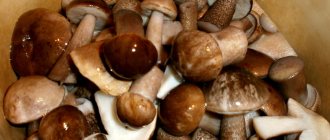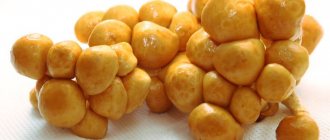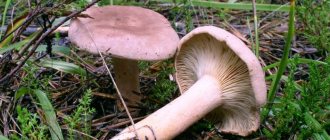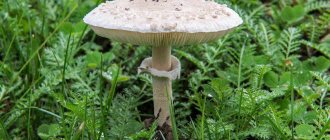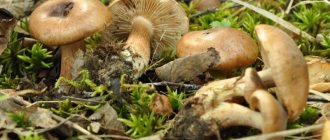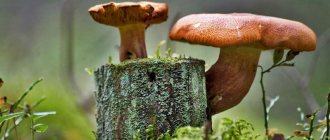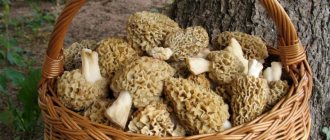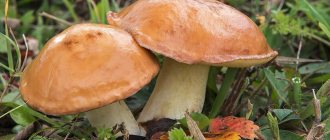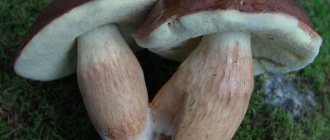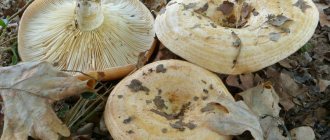The identification of mushrooms as boletus species and the delineation of this genus from the Boletus species is unclear and controversial. Moss fly mushrooms represent a heterogeneous mixture of several groups and species. These groups are separated from each other by different anatomical and some other features. Also, recent research by mycologists shows that flywheels do not descend from one common fungal ancestor.
Etymology of the name "moss fly"
The fruiting bodies of this species occupy moss-covered clearings in coniferous and mixed plantings. Mushroom pickers collect moss mushrooms from late spring until the first frost. Almost all mushrooms of this species are edible, the only exception being false fly mushrooms.
Description of the flywheel mushroom
Moss flyflies from different genera have unique generic characteristics, but they are all united by the following characteristics:
hat
A little dry and velvety. In overripe specimens, the skin cracks. The size of the cap depends on the stage of life, but does not exceed 9 cm.
Pulp
The color appears at the incision site. The body remains white, turns yellow, turns red, and in most species turns blue.
Hymenophore
The pores of the tubes are wide, showing red, yellow to greenish-yellow colors. After damage, the tubes turn blue.
Leg
The texture depends on the species, wrinkled or smooth, the stem grows up to 8 cm in height.
Spore Seal
The shade depends on the species.
conclusions
There are many types of healthy and tasty moss mushrooms. It is important not to make a mistake or confuse them with false mushrooms. Although there will be no danger in this case. Just a bitter, unpleasant taste.
The difference between a real, tasty mushroom and a false one is manifested in taste characteristics, appearance, texture of the pulp, as well as a pleasant, mushroom smell. Good luck with your mushroom harvest.
Shiitake - appearance, composition, benefits and harm, mushroom cultivation + 72 photos- Talker - description of the species, distribution of the species, benefits and harm + 79 photos
- Gall mushroom - description of appearance, seasonality, taste + 69 photos
Edible fly mushrooms
In the Boletov family, moss mushrooms have a relative - the boletus mushroom. People collect the following fly mushrooms for food:
- motley;
- red;
- green;
- Polish;
- yellow-brown.
Moss fly green
It is found mainly under broad-leaved trees, on the edges of coniferous plantations where birch and willow grow.
Since the mushroom does not have any special characteristics, a simple chemical test helps to confidently identify it as belonging to the genus Green Flyfly: the cap turns bright red if a drop of household ammonia is applied to it.
Habitat
The green moss is found in most parts of continental Europe, Asia and North America, Australia.
hat
In young mushrooms, it is hemispherical and pubescent, becomes smooth and sometimes cracks as the fruiting bodies ripen, exposing the yellow flesh under the cuticle.
When fully opened, the umbrellas of the caps become brown or olive, 4 to 8 cm in diameter with uneven, somewhat wavy edges.
Tubes and pores
Chrome-yellow in color, darkening with age, the tubes are congenitally attached to the stalk. When bruised, the pores (but not in all samples) turn blue, then the area turns brownish.
Leg
Pale, like a cap or a little darker, sometimes slightly convex at the base and widens towards the cap. The flesh of the stem does not change color significantly or turns slightly red when cut and exposed to air. From 1 to 2 cm in diameter, length from 4 to 8 cm.
The spore seal is olive-brown. The smell/taste is not distinctive.
Habitat and ecological role
This mycorrhizal fungus occurs singly or in small groups under broad-leaved trees in parks and mixed forests, especially in limestone soils.
Green mushroom in cooking
The boletus is edible, but not highly valued. It is added to other mushrooms in dishes, dried and stored for later use.
Moss fly yellow-brown
This soft-bodied mushroom is collected in or near pine plantations, and often among heather. It grows in small groups, not families. The pores of young specimens secrete characteristic milky droplets. In wet weather the caps are slightly sticky rather than slimy.
Habitat
In continental Europe, the yellow-brown moss is often found in northern latitudes, becoming increasingly rare closer to the south, although the range extends to Asia. This species is also found in some parts of North America.
hat
Yellowish-yellow to yellowish-brown in color, the surface is almost always dry (except in wet weather), finely velvety or finely scaly, grows to 4-10 cm in diameter and remains slightly convex. The flesh is pale yellow and soft, turning noticeably blue when cut.
Tubes and pores
The asymmetrical, slightly angular tubes are mustard-colored and end in olive-ochre pores that turn cinnamon-mustard when fully ripe.
Leg
The slightly convex stem is straw-yellow in color and has no ring or annular zone. When cut, the pale yellow flesh of the stem does not change color significantly.
Spore Seal
Ocher or blue-brown. The smell is not distinctive, the taste is quite sour.
Yellow-brown flywheel in cooking
Edible, however, when cooked it has a metallic taste and an unpleasant odor.
Believed to upset the stomach. Therefore, it is advisable to clean the caps, remove the layer of tubes, cook thoroughly and then, as with any other edible mushroom that is tried for the first time, eat small portions until you are sure that there are no adverse reactions.
Moss fly red
A cute little ectomycorrhizal fungus that grows in rich soil under deciduous trees, especially loves beech and oak, breeds in groups rather than singly, and is found on forest edges, in clearings, meadows, parks and gardens.
Habitat
Rare or completely absent in northern latitudes, the mushroom prefers a warmer European climate and is found in groups of 3 to 10 specimens.
hat
3 to 8 cm wide, broadly convex and then flattened, sometimes with a small central depression. Young mushrooms are scarlet, transitioning to a mature color of olive-red with a yellowish marginal stripe. The surface is dry and velvety, rarely cracking even in old mushrooms.
Tubes and pores
The tubes are dull yellow, the pores are lemon yellow, turning greenish with age. When damaged, the pores and tubes slowly turn blue.
Leg
4 to 8 cm long, 4 to 8 mm in diameter, cylindrical, bright yellow at the top and gradually turns red towards the base. The flesh is pale yellow, becoming deep yellow at the base and turning blue when cut.
The spore seal is olive-brown. Faint pleasant smell, not pronounced taste (a little soapy).
Red flywheel in cooking
These small mushrooms are often infested with larvae when mature. The taste and faint smell are not conducive to cooking or frying. The mushroom is pickled or dried and used together with other mushrooms.
Polish flywheel
Distributed in spruce and pine forests, it also appears under oaks, beeches, chestnuts and many other broad-leaved trees.
Late summer and autumn are the main season for hunting for the edible mushroom, which is comparable in taste to porcini mushrooms and is less often infected with larvae, even when the umbrella of the cap is fully opened.
Habitat
The Polish moss is a fairly common species in the temperate climates of Europe and North America. Rarely grows in groups of more than two or three specimens; up to 4-5 mushrooms are found under old pines.
hat
Large, smooth brown or chestnut, slightly pubescent in immature mushrooms. It grows up to 5-15 cm in diameter, has firm, pale flesh that turns blue when cut.
Flesh
The flesh of the cap and stem is whitish or sometimes yellowish in color during the initial life stage of the Polish flywheel, becoming furrowed just below the cuticle of the cap and turning slightly blue in the area just above the tubes and at the top of the stem.
Tubes
Pale yellow, turning blue when cut, ending in pale yellow angular pores that (almost always) turn bluish-green when cut. The color change occurs quickly and is most noticeable in mature mushrooms, and if you touch the pores, it will leave a dark blue mark on your hands.
Leg
The brown leg is covered with thin cotton threads that give it a striped appearance. There is no ring, the diameter is more or less even, although the stem is often slightly curved, especially near the base. From 2 to 3 cm in diameter, from 5 to 15 cm in height. The flesh is white or pale lemon and turns slightly blue when cut.
The spore seal is olive-brown. Mild mushroom taste, no distinctive smell.
Polish flywheel in cooking
The mushrooms are large and fleshy. In any recipe, porcini mushrooms are replaced with porcini mushrooms, and eaters do not realize from the taste that a substitution has occurred. These mushrooms are dried for storage, cut into thin vertical slices, then frozen for later use.
Variegated flywheel
It is a rare species in continental Europe. Variegated flywheel is found under coniferous trees, but sometimes also among beech trees.
hat
Shallow, convex, gray-yellow or brownish, cracking, revealing a thin layer of red flesh under the skin. The diameter is from 4 to 10 cm, when fully opened, the thin flesh turns slightly blue when cut.
Tubes and pores
The yellow tubes end in large, angular, lemon-yellow pores that become dirty olive with age. When bruised, the pores of mature specimens slowly turn greenish-blue.
Leg
It has no ring and is bright yellow with coral-red fibrils that give the appearance of rhubarb. When cut, the flesh of the stem turns red just below the outer shell, in other places it is creamy and does not turn blue. From 10 to 15 mm in diameter and from 4 to 8 cm in height, the diameter is the same along its entire length.
The spore seal is olive-brown. The smell/taste is not distinctive.
Variegated flywheel in cooking
Mature specimens are of little culinary interest due to their slimy texture. The mushroom is edible if cooked thoroughly.
Places and times of growth
Different types of mushrooms grow in different places. For example, the Polish mushroom is found in Siberia and the North Caucasus. It prefers coniferous forests, growing on sandy soils.
The red moss can be found in the Far East. This type of mushroom can also be found in North African countries and in the deciduous forests of Europe.
Green moss mushroom grows everywhere, in forests with deciduous and coniferous trees.
Semi-golden moss can be found in the forests of the Caucasus, as well as the Far East.
Mushrooms begin to actively grow in July and complete fruiting in September, but these periods are different for different types of flywheel. For example, the Polish mushroom is harvested from June to November, and the red flywheel - in August and September.
False flywheels
Parasitic moss fly
Non-toxic, bitter, unpleasant in taste, grows on the remains of the false puffball. The cap is up to 5 cm in diameter and does not turn blue when damaged.
Chestnut mushroom
Brown-red, convex, up to 8 cm in diameter, does not change color when cut. Cylinder leg 3.5 x 3 cm to match the cap. This mushroom is edible, but only after boiling and drying. Then the bitterness disappears.
Bile mushroom
The massive stem resembles the stem of a porcini mushroom. The diameter of the spongy cap is up to 7 cm. The reddish flesh tastes bitter and burns the tongue. Arthropods do not eat or lay larvae in this mushroom.
Pepper mushroom
The cap is light brown, convex, up to 7 cm in diameter. The flesh is loose, yellow, reddish when cut, and tastes hot and peppery. The leg is bent, cylindrical, the color matches the cap, yellower near the ground.
Parasitic species
Harmful mushrooms often grow near edible mushrooms; it is important to understand how to distinguish them from normal mushrooms. This species is not life-threatening and is not classified as poisonous, but when cooked it has an unpleasant taste.
Fake mushrooms have a bitter taste; it is by this characteristic that they can be distinguished from real mushrooms. Its types: chestnut, pepper, gall mushrooms.What are the health benefits of flyweed?
This is a low-calorie mushroom with low nutritional value, but with a high content of essential oils, which promote the absorption of food served with flywheels.
Moss mushrooms accumulate molybdenum, a metal that is involved in many processes in the body. The fruiting bodies also contain:
- vitamin A;
- calcium;
- essential oils;
- enzymes.
In folk medicine, fly mushrooms are used to treat inflammatory processes in the body. Mycologists have discovered natural antibiotics in the flesh of the mushroom.
Let's talk about secrets
Most often, edible moss mushrooms grow at the base of trees or stumps, in moss. The cut acquires a blue tint after 5 seconds due to contact with air. When cut, the leg first turns blue, then turns brown, and then becomes light again.
Information sources
- Dermek A. Mushrooms. - Bratislava: Slovart, 1989.
- Dermek A.
Mushrooms. - Bratislava: Slovart, 1989. - Deaf mushroom // Great Soviet Encyclopedia: in 66 volumes (65 volumes and 1 additional) / ch. ed. O. Yu. Schmidt. - M.: Soviet Encyclopedia, 1926-1947.
When is it better to avoid flywheels?
The caps of the fly agaric and the panther fly agaric are similar. In a poisonous mushroom it is lamellar, in moss mushrooms it is tubular. Therefore, if you do not have experience in identifying flywheels, it is better not to collect mushrooms unless you understand the peculiarities of the morphology of mushrooms.
Like other species, moss mushrooms are difficult for the human gastrointestinal tract even after cooking. They aggravate the course of stomach and liver diseases, food allergies. Children do not have the enzymes to digest mushroom food, not just fly mushrooms.
Avoid clearings with mushrooms near roads, industrial enterprises and strips near agricultural fields industrially cultivated from the air. Moss mushrooms readily accumulate harmful substances and retain them even after careful preparation.
Cooking recipes
Moss fly salad
After a “quiet hunt,” a novice mushroom picker has a problem: how to cook moss mushrooms appetizingly, despite their mediocre taste declared in all culinary reference books?
The main thing is to remember an important thing - flywheels immediately begin to darken from interaction with air, so fresh peeled mushrooms are immediately immersed in water, adding 2 g of citric acid and a teaspoon of salt per 1 liter.
When pickled and pickled, mushrooms are excellent preparations for the winter, but they are extremely rarely used for drying - due to the same characteristic darkening. To prepare dishes from moss mushrooms, both caps and legs are used. Moss mushrooms do not need to be pre-boiled before frying or adding to soups, and the Polish mushroom is also eaten raw as the main accent of salads. The “Awesome” salad is incredibly tasty, although the moss mushrooms used for it are still pickled.
Salad with Polish mushroom
Main ingredients:
- mushrooms – 0.5 l jar,
- processed cheese – 100 g,
- boiled potatoes – 5–6 pieces,
- pickled cucumber – 2-3 pieces,
- mayonnaise for dressing,
- greens to taste.
Experienced cooks recommend using cucumbers for this salad from a marinade with citric acid rather than vinegar. All components of the dish are crushed, mixed and seasoned with mayonnaise, and greens are added at your discretion.
Moss mushrooms for this salad, and for many other dishes, are prepared for the winter as follows:
Marinated moss mushrooms
Mushrooms are cleaned and thoroughly washed, damaged ones and those that are too large are sorted out, leaving caps no more than 5–6 cm in circumference.
Place in a saucepan, add water and bring to a boil, then boil for 10–15 minutes over low heat and drain the contents into a colander. Allow the water to drain while preparing the marinade. Add 1 tablespoon of salt and sugar to 1 liter of water, add 2 small bay leaves, a few cloves of garlic and just a little cloves. After boiling, pour 1 tbsp. a spoonful of vinegar and transfer the mushrooms to the pan. Boil in the marinade for 5 minutes, then place in sterilized glass containers so that the liquid covers the entire contents, and roll up.
Moss mushrooms make delicious soups, stewed or fried side dishes, and baked in sour cream they can easily claim to be an exquisite culinary masterpiece.
You will learn more about flywheel mushrooms from the video.
Beneficial features
Flywheel mushrooms contain a lot of useful substances that have the following effects on the body:
- normalize the functions of the nervous system;
- accelerate tissue regeneration;
- slow down the aging process;
- accelerate the removal of toxins;
- normalize cholesterol and blood sugar levels;
- improve the functioning of the heart and circulatory system;
- increase immunity.
Flywheels are also considered a natural antibiotic, and they are recommended to be used for colds and infectious diseases to speed up recovery.
Collection rules
Moss fly mushrooms found in the forest are checked for similarity to their doubles. Their fruiting bodies are thoroughly cleaned of soil, sticky needles and leaves. Further processing of the collected mushrooms is as follows:
- Items that are planned to be dried do not need to be washed. The rest must be washed with a brush, going over both the caps and the legs.
- Then the spots, damaged and hard areas of the fruiting bodies are cut off with a knife.
- Remove the layer of spores located under the cap.
- The mushrooms are soaked. They are placed in a container with cold water and left for 10 minutes. Then dry on a towel or napkin.
Interesting Facts
Xerocomellus pruinatus.
Some sources claim that the name “velvet” is not entirely true. In fact, the coating on the cap of this mushroom looks more like wax or frost. So it would be more accurate to call it “frosted”, which, by the way, is reflected in its Latin name - Xerocomellus pruinatus (pruina - literally “drizzle”). And the term Xerocomellus, literally meaning “moss fly”, consists of the words “dry” (Greek: Xersos) and “fluff” (Greek: kome).
